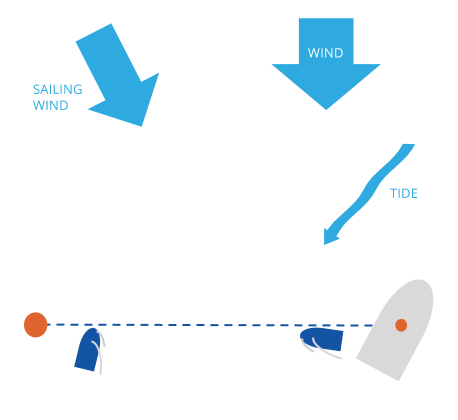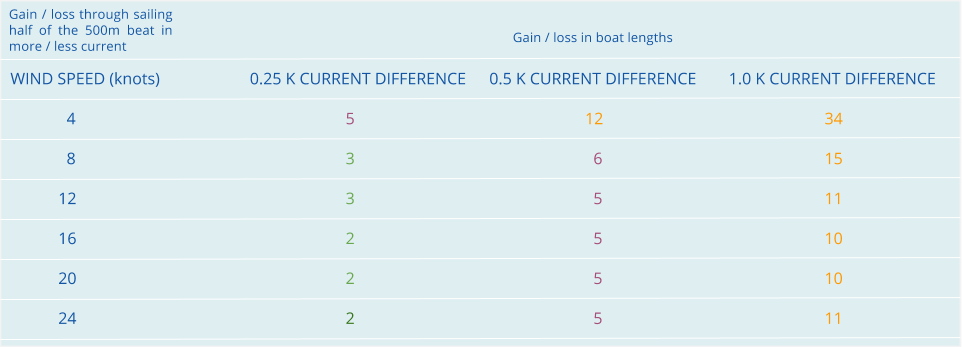There are many statistics and many more books talking about how important it is to start a regatta in the best possible way. It doesn’t matter if we are sailing in a fleet regatta or in a match race, a good start will give us many options and good confidence for the rest of the regatta. We know that for a good start there are many factors to consider and many decisions to make; in this article we want to focus on two particular aspects of the starting strategies:
- The timing
- The line’s bias
Why we want to focus on these two? Well, because the current plays a key role in these two aspects of the start!
First of all, we must remember an important rule of sailing in current: the lower the ratio boat speed/current strength is, the higher is the influence of the current on our course and speed.
This becomes very important in the pre-start when we manoeuvre the boat a lot and are often slow. Let’s see an easy example:
Suppose we have not assessed the current in the start area; we have decided to get close to the line early, to keep the boat almost stopped and accelerate just before the start (not an unusual starting technique at all). We do all our manoeuvres and finally find ourselves two, three boat lengths from the line and try to slow the boat down. But, even if the sails are flapping, the boat keeps getting closer and closer to the line… Obviously, there is current pushing us and we haven’t considered it. By the time we realize it, it’s too late: we are stuck between other boats, can’t manoeuvre and end up over the line before the gun.
This is just an example, but not far from what really happens during regattas: I remember an IRC regatta in Saint Tropez last year. Just enough wind to race and 2/3 knots of current pushing over the line. Even having many professionals racing on different boats, the committee had to give 3 general recalls because too many boats were over the line before the gun. Finally the start was given with the black flag hoisted on the committee boat (i.e. A boat within the triangle formed by the ends of the line and the first mark during the minute before the start will be disqualified without a hearing).
When the current flows against us on the start line, we have the opposite problem. If we slow down the boat too much, it’s hard to re-accelerate, we will have to bear away a lot, and we’ll probably be late on the line.
 The current should also affect how the race committee sets the start line but sometimes, especially with inexperienced race officers, we find a bias on the line. Why? Well, the race committee measures the wind from a boat at anchor: this means that with its instruments are actually measuring the ground wind and not the true wind (sailing wind) we are sailing in. Looking at the figure we see an example where the line is square (perpendicular to the wind) to the ground wind, but it is actually biased compared to the sailing wind and, therefore, will be convenient to start close to the pin.
The current should also affect how the race committee sets the start line but sometimes, especially with inexperienced race officers, we find a bias on the line. Why? Well, the race committee measures the wind from a boat at anchor: this means that with its instruments are actually measuring the ground wind and not the true wind (sailing wind) we are sailing in. Looking at the figure we see an example where the line is square (perpendicular to the wind) to the ground wind, but it is actually biased compared to the sailing wind and, therefore, will be convenient to start close to the pin.
This bias changes the geometry of the line and, therefore, also the pin’s and committee’s laylines.
Generally speaking, it is important to highlight this: whenever we sail close or around something fixed to the ground (a mark, an headland, a boat at anchor…) the influence of the current on our course over the ground becomes obvious and has to be assessed carefully. The start line is an imaginary line fixed to the ground (the committee boat and the mark are anchored) so, next time you race, don’t forget to check the current!
Author: Gilberto Pastorella
Missed the previous chapter of our CURRENTS & TACTICS?
Read it here: CURRENTS & TACTICS II – The Wind Triangle.

